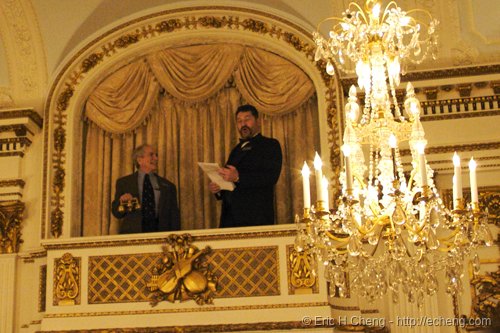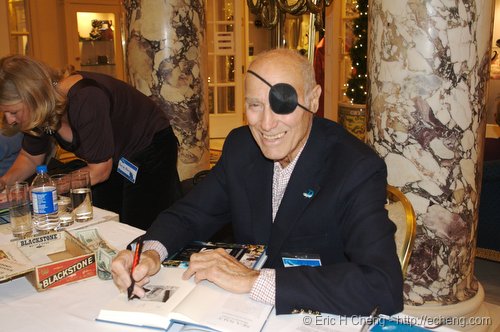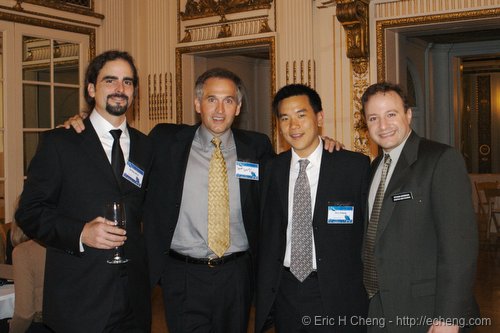Boston Sea Rovers 53rd Clinic 2007
In late 2003, Steve Drogin suggested that I apply to give a seminar at the annual Boston Sea Rovers Clinic. Being completely new to the industry, I had no idea who the Sea Rovers were nor what their clinic was all about. A few months later, I arrived at the Fairmont Copley Plaza hotel in Boston to find the most amazing dive show I had ever seen.
Although the annual clinic has limited space for booths, its speaker line-up and Saturday evening film festival are typically the main draw for visitors. The show is run solely by volunteers, and all proceeds are used for scholarships, internships, and support of other non-profit organizations (the Sea Rovers themselves are a 501C3 not-for-profit organization). All of the daytime speakers pay for the expenses involved in getting to and staying in Boston, yet each year there are many more applications for speaking slots than can be accepted.
To show appreciation for the festival’s daytime speakers, workshop presenters, and film-festival presenters, the Boston Sea Rovers host a pre-clinic speakers’ reception and official kick-off party on the Friday night before the clinic opens. Here in the States, I can’t think of any other event that is so densely packed with such big names in the industry. Combined with an unlimited supply of appetizers and alcohol, it’s quite a party. And each year, Sea Rovers president Dave Morton waits until the guests have had plenty of time to saturate themselves with ethanol before climbing to a booth near the ceiling of the ballroom and reciting a poem, after which bells are rung and the annual clinic officially begins.

Dave Morton recites a poem
I gave a seminar on Saturday afternoon, and for the first time, eschewed everything technical in order to focus on how to find animals in the “A list” of shark and whale species. It was a lot of fun, and I’d love to continue doing talks that don’t involve the words, “chromatic aberration” and “Bayer interpolation.” Among the list of distinguished daytime presenters at the clinic this year were Jeff Rotman, Annie Crawley, John Ellerbrock, Steve Drogin, Mauricio Handler, Stan Waterman, Andrew Martinez, and many more. It is a somewhat futile gesture to try to distill the full list into anything smaller; instead, take a look at the entire schedule. Some folks come to the clinic each year just to sit in seminars for two days.

The last remaining playboy of the industry,
Stan Waterman, autographs his book, Sea Salt, for me
Aquatica, Light & Motion, Underwater Photo-Tech, and Amphibico showed underwater housings, lights, and more at their booths. Aquatica had a production version of their AquaView viewfinder and their new, 9.25”, optical-glass “Megadome”.
Saturday night’s evening film festival featured master of ceremonies Ernie Brooks, who introduced Brian Skerry, Doug Allan and Sue Flood, Feo Pitcairn, and a representative from the Odyssey Marine Explorations group. Mr. Brooks gave heart-felt introductions about each of the presenters—so heart-felt that he sometimes couldn’t resist speaking to the presenters themselves (who were offstage, out of our view from the audience).
After a trailer for the new movie, Sharkwater, a representative from the Odyssey group came on stage and began his talk by announcing, “I’m just a caveman…,” before showing a long piece about the discovery and salvage of an old, steam-powered paddle boat that went down in a storm during the mid-1800s. Unfortunately, the film consisted only of random raw footage. It had no narration and included terrible, repetitive, unrelenting music that nearly drove me—and those around me—crazy. A few people even left the theater.
I did some web searches when I arrived at home after the clinic, and it looks like the paddle boat story would have been quite interesting if we had been told anything about what we were seeing. Apparently, the ship settled 1,700 feet below the surface with what is now worth around $150 million in gold coins. Odyssey decided to do an archaeological recovery on the vessel instead of just looting it for its gold, and this, of course, presented numerous technical challenges.
Thankfully, the film festival redeemed itself quickly after its slow start.
Brian Skerry showed images from his latest National Geographic story on sharks in the Bahamas (out in the current issue), followed by a preview of an upcoming 38-page article on global fisheries. He showed images from below the water of long-lining, shrimp trawling, and more—all beautiful, but tremendously depressing at the same time. On a technical note, the projection of Skerry’s high-resolution imagery was absolutely perfect, and the images looked incredible.
Feo Pitcairn showed footage he and Bob Cranston had acquired during a few weeks in French Polynesia, where they spent two weeks with two humpback whales—a mother and a newborn calf. We, the audience, were thoroughly stunned by what we saw, which was mind-boggling for those of us who know what it takes to get such footage. Over the course of two weeks, the whales developed an incredible trust of the two cameramen and allowed them to approach and film closely even while the calf was nursing. Upon seeing some of the behind-the-scenes footage (of one of them getting whacked by the calf’s fluke), we realized that all of it had been done on open circuit SCUBA!
Doug Allan and Sue Flood brought peals of laughter to the audience by relating exciting (and hilarious) stories about their experiences working in the Arctic and Antarctic for the BBC (specifically, for the Blue Planet and Planet Earth series). Most of the talk used behind-the-scenes still photographs to show the audience what goes on during a typical shoot in polar regions. Sue told a story about accidentally peeing in her parka’s hood and then dumping its contents over her head as she boarded a helicopter (it wasn’t the only story about pee that she told), Doug showed an underwater photo he took of migratory birds feeding in the Arctic a mere 5 seconds before a walrus grabbed him from behind, and they both spoke of the circumstances leading up to Doug’s marriage proposal to Sue, which involved thin ice. The photos and stories were ones of true adventure and exploration. Appropriately, Doug’s parting words were, “well, I’ve got to catch a flight to the North Pole.”
By the end of the show, and all I could see in the faces of the audience members around me were excited smiles.
A party back at the Fairmont completed the evening, where new inductees into the Boston Sea Rovers are held upside-down and dunked into a bowl of orange juice and vodka.

Berkley White (Backscatter), Brian Skerry (National Geographic)
Eric Cheng (Wetpixel), Ethan Gordon (Fathoms Magazine)
On Sunday, the exhibit hall seemed a bit empty, but for good reason. Everyone had crammed into one of the seminar rooms to see Rob Stewart present the New England premiere of Sharkwater, a story of his journey documenting efforts to save sharks from overfishing.
I apologize if I sound overly exuberant in my description of the Boston Sea Rovers Clinic, but if you are a fan of the ocean and love watching documentaries about discovery, there is no better dive show you can attend!